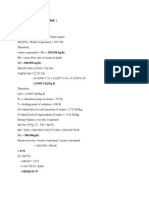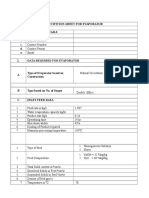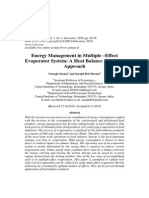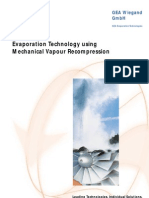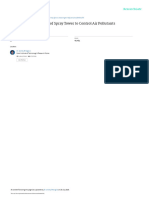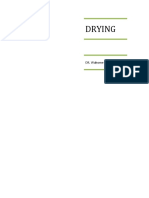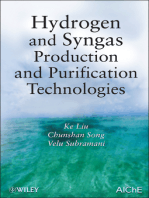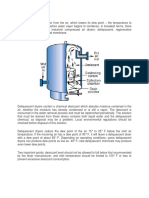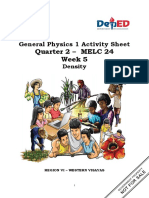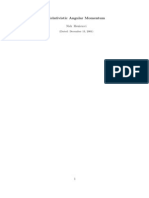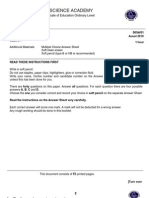0 ratings0% found this document useful (0 votes)
145 viewsDesign of Dryer
Design of Dryer
Uploaded by
HARKULVINDER SINGHThe document discusses the design of a rotary dryer. It provides an overview of the design process and key considerations, such as solid and gas flow rates, inlet/outlet moisture contents, temperatures, and heat transfer. An example design problem is then presented and solved step-by-step to estimate the dryer diameter, length, and other parameters based on given operating conditions and material properties. The dryer is divided into three stages and design calculations are done using material and energy balance equations to iteratively determine stage temperatures and humidities.
Copyright:
© All Rights Reserved
Available Formats
Download as DOCX, PDF, TXT or read online from Scribd
Design of Dryer
Design of Dryer
Uploaded by
HARKULVINDER SINGH0 ratings0% found this document useful (0 votes)
145 views11 pagesThe document discusses the design of a rotary dryer. It provides an overview of the design process and key considerations, such as solid and gas flow rates, inlet/outlet moisture contents, temperatures, and heat transfer. An example design problem is then presented and solved step-by-step to estimate the dryer diameter, length, and other parameters based on given operating conditions and material properties. The dryer is divided into three stages and design calculations are done using material and energy balance equations to iteratively determine stage temperatures and humidities.
Original Description:
calculations
Copyright
© © All Rights Reserved
Available Formats
DOCX, PDF, TXT or read online from Scribd
Share this document
Did you find this document useful?
Is this content inappropriate?
The document discusses the design of a rotary dryer. It provides an overview of the design process and key considerations, such as solid and gas flow rates, inlet/outlet moisture contents, temperatures, and heat transfer. An example design problem is then presented and solved step-by-step to estimate the dryer diameter, length, and other parameters based on given operating conditions and material properties. The dryer is divided into three stages and design calculations are done using material and energy balance equations to iteratively determine stage temperatures and humidities.
Copyright:
© All Rights Reserved
Available Formats
Download as DOCX, PDF, TXT or read online from Scribd
Download as docx, pdf, or txt
0 ratings0% found this document useful (0 votes)
145 views11 pagesDesign of Dryer
Design of Dryer
Uploaded by
HARKULVINDER SINGHThe document discusses the design of a rotary dryer. It provides an overview of the design process and key considerations, such as solid and gas flow rates, inlet/outlet moisture contents, temperatures, and heat transfer. An example design problem is then presented and solved step-by-step to estimate the dryer diameter, length, and other parameters based on given operating conditions and material properties. The dryer is divided into three stages and design calculations are done using material and energy balance equations to iteratively determine stage temperatures and humidities.
Copyright:
© All Rights Reserved
Available Formats
Download as DOCX, PDF, TXT or read online from Scribd
Download as docx, pdf, or txt
You are on page 1of 11
DESIGN OF DRYER
Design of a rotary dryer only on the basis of
fundamental principle is very difficult. Few of
correlations that are available for design may not
prove to be satisfactory for many systems. The
design of a rotary dryer is better done by using
pilot plant test data and the full scale operating
data of dryer of similar type if available, together
with the available design equations. A fairly large
number of variables are involved such as solid to
be dried per hour, the inlet and exit moisture
contents of the solid, the critical and equilibrium
moisture contents, temperature and humidity of
the drying gas. The design procedure based on
the basic principles and available correlations is
discussed below. In this case we assume that the
solid has only unbound moisture and as shown in
fig 2.7 in stage II the solid is at the wet bulb
temperature of the gas.
Figure 2.7 : Temperature profile for solid and
gas in a counter current rotary dryer
1.1. Heat losses from dryer surfaces are
neglected.
2.
3.
4.
5.2. Once the capacity of the dryer is known, the
drying gas flow rate, its temperature and humidity
are decided considering a number of factors. And
the following moisture & enthalpy balances need
to be satisfied.
Here, Gs = flow rate of air (dry basis, kg/h), Ms =
flow rate of solid (kg/h, dry basis), Hs = humidity
of air (kg/H2O/kg dry air)
3. The gas and solid temperatures at the stage
boundaries are obtained by moisture and energy
(enthalpy) balances. The number of heat transfer
unit for each zone is calculated. for the stage II.
The number of heat transfer units is given by
4. The total length of dryer is given by
5. The shell diameter is calculated from the dry
gas flow rate (from step I) and suitable gas flow
velocity or gas mass flow rate
Some useful correlations for the design of a rotary
dryer are given below.
Volumetric gas-solid heat transfer coefficient.
Here, cH= average humid heat, and d = dryer
diameter
Solid retention time:
( +ve sign is for counter flow;
ve sign is for parallel flow of the gas and solid)
Where,
= retention time (min); L = dryer length (m)
S = slope of the dryer (m/m); N = speed (rpm)
G' = gas mass flow rate (Kg/m2 .h)
F = feed rate (Kg/m2 . h) dry basis
B = 5 (dp) -0.5
dp = weight average particle diameter (micron)
d = dryer diameter (m)
E xample 2.1 : Size of the rotary dryer can be
estimated for the following case. A moist non
hygroscopic granular solid at 26C is to be dried
from 20% initial moisture to 0.3% final moisture
in a rotary dryer at a rate of 1500 kg/h. The hot
air enters the dryer at 135C with a humidity of
0.015. With condition that the temperature of the
solid leaving the dryer must not exceed 110C
and the air velocity must not exceed 1.5 m/s in
order to avoid dust carry over. Cps = 0.85 kJ/kg.K.
Recommend the diameter, length and other
parameters of the dryer.
Solution:
Basis of calculation is 1 hr operation
Solid contains 20% initial moisture
Mass of dry solid = MS = 1500 (1-0.2) = 1200
kg/hr
Moisture in the wet solid = X1 = 20/80 = 0.25
Moisture in the dry solid = X2 = 0.3/99.7 = 0.00301
Water evaporated, mS, evaporated = MS (X1 X2)
= 1200 (0.25
0.00301) = 296.4 Kg
Given data:
TS1 = 26C; TG2 = 135C; Y2 = 0.015
Let us assume that the exit temperature of the
gas is TG1 = 60C and for solid TS2 = 100C
Now enthalpy of different streams (suppose ref
temp = 0C)
Overall mass balance
Shell Diameter
Heat Transfer Unit
Dryer is divided into three zones and therefore,
the stage wise calculation of temperature and
humidity of the stream can be obtained by
material and energy balance.
Stage III
Very less water left for vaporization in stage III.
Consider solid is at TSB, the wet bulb temperature
of the air at location between III & II.
assume TSB = TSA = 41C
Enthalpy of solid at the inlet to stage III
HSB = [0.85 + (0.00301) (4.187)] (41-0)
= 35.37 KJ/kg dry solid
Humid heat of gas entering stage III
CHB = [1.005 + (1.88) (0.015)]
= 1.003 KJ/kg.K
Heat balance over stage III
MS [HS2 - HSB ] = GS (CHB )III (135 TGB )
TGB = 129C
Adiabatic saturation temperature of air entering
stage II (129C & humidity of 0.015) is 41.3C.
At the boundary B, TB = 129 -41 = 88C
At end 2, T2 = 135 -100 =
35C
LMTDIII = (T)m = 88-35/ln(88/35) = 57.5C
(NtG )III = T2 TGB / (T)m = 135 -129/57.5 = 0.104
Stage II
Use heat balance equation over stage II to
calculate the value of TGA . The
calculated TGA value can be use to estimate the
number of transfer units.
Enthalpy balance:
Once H-GA value is known then TGA can be
calculated using the following equation
At section A temp diff. TA = 63 -41 = 22C and
TB = 88C
(T)M = (88-22)/ ln(88/22) = 47.6C
Number of transfer unit = (NtG )II =
TGB TGA /(T)M
= (129 63)/47.6 = 1.386
To validate the assumed value of exit gas
temperature i.e. TG1 = 60C, first do an energy
balance over stage I.
Stage I
Length of Transfer Unit :
Avg. mass flow rate = [10560 (1.015) + 10560
(1.04306)]/2
= 10867 Kg/h
The gas mass flow rate, G' = (10867/3600)/ / 4
(2)2
= 0.961 Kg/m2.S
Volumetric heat transfer coeff. = = ( 237
(G')0.67 )/d
= (237 (0.961)0.67)/2 = 115 W/m3.K
Humid heat at the ends
CH2 = 1.005 + 1.88 (0.015) = 1.033
CH1 = 1.005 + 1.88 (0.04306) = 1.083
Avg. humid heat,
CH = (1.033 + 1.083)/2 = 1.058 KJ/Kg. K
Length of transfer unit, LT = G'. CH / = (0.961
1058)/115 = 8.84 m
Length of dryer, L = NtG . LT
= 1.56 8.84 = 13.8 m
D = 2 m and L = 14 m
You might also like
- Design and Operation of Wet Dust ScrubbersDocument2 pagesDesign and Operation of Wet Dust Scrubbersgaziahmad0% (2)
- Plate Type Wet ScrubberDocument6 pagesPlate Type Wet ScrubberRoger Isidore100% (1)
- No Objection Certificate FORMAT (FOR CAR)Document6 pagesNo Objection Certificate FORMAT (FOR CAR)HARKULVINDER SINGH100% (1)
- Active Cooling System For Photovoltaic ModulesDocument7 pagesActive Cooling System For Photovoltaic Modulesakhilesh120No ratings yet
- Lurgi PSI Evaporator PaperDocument13 pagesLurgi PSI Evaporator PaperMariAle Droz CastroNo ratings yet
- Noniterative Design of Multiple Effect Evaporators Using Excel Add InsDocument10 pagesNoniterative Design of Multiple Effect Evaporators Using Excel Add InsGalang Hanif AbdulahNo ratings yet
- Dryer Selection and DesignDocument43 pagesDryer Selection and DesignMuluken DeaNo ratings yet
- CEB2063 - Evaporation - Lecture 1 (Group 1)Document28 pagesCEB2063 - Evaporation - Lecture 1 (Group 1)Scorpion RoyalNo ratings yet
- WorkDocument43 pagesWorkAkash GundaleNo ratings yet
- Double Effect EvapDocument32 pagesDouble Effect EvapJubell MogoteNo ratings yet
- Heat ExchangersDocument29 pagesHeat Exchangersprotoscope photographyNo ratings yet
- Convection Heat Transfer CoefficientDocument9 pagesConvection Heat Transfer CoefficientAnonymous sAmJfcVNo ratings yet
- Design For EvaporatorDocument5 pagesDesign For EvaporatorDevang GodhaniyaNo ratings yet
- Activated Carbon From Jackfruit Peel Waste by H3PODocument13 pagesActivated Carbon From Jackfruit Peel Waste by H3POMaria De La HozNo ratings yet
- EvaporatorDocument30 pagesEvaporatorHerdiani Hidayanti100% (1)
- Condenser DesignDocument12 pagesCondenser Designbirendrajee100% (1)
- Falling Film Evaporator-MEng-ThesisDocument206 pagesFalling Film Evaporator-MEng-ThesisElza Febrianty AngrainiNo ratings yet
- 6 Crystallizer Design and OperationDocument48 pages6 Crystallizer Design and OperationAjeet SinghNo ratings yet
- Energy Saving in Spray Drying ProcessDocument15 pagesEnergy Saving in Spray Drying ProcessJorge OsorioNo ratings yet
- Specifition-Sheet For Evaporator 1. Customer Details A. B. C. D. E. 2. Data Required For EvaporatorDocument2 pagesSpecifition-Sheet For Evaporator 1. Customer Details A. B. C. D. E. 2. Data Required For EvaporatorTowfiq Hossain TaskuNo ratings yet
- Growth Kinetics of Oleaginous Yeast, Rhodosporidium Toruloides, in High Salinity ConditionDocument79 pagesGrowth Kinetics of Oleaginous Yeast, Rhodosporidium Toruloides, in High Salinity ConditionShimme7No ratings yet
- Heat Exchanger Effectiveness PDFDocument5 pagesHeat Exchanger Effectiveness PDFfrilofhNo ratings yet
- Determination and Correlation of Heat Transfer Coefficients in A Falling Film EvaporatorDocument7 pagesDetermination and Correlation of Heat Transfer Coefficients in A Falling Film EvaporatorSeyit AvcuNo ratings yet
- Evaporator: Prof Ir Dr. Ab Saman B. Abd Kader, Peng, Miem, Mcit Faculty of Mechanical Engineering, UtmDocument54 pagesEvaporator: Prof Ir Dr. Ab Saman B. Abd Kader, Peng, Miem, Mcit Faculty of Mechanical Engineering, Utmakusuper100% (1)
- Energy Management in Multiple Effect EvaporatorDocument5 pagesEnergy Management in Multiple Effect EvaporatorI. Murali KrishnaNo ratings yet
- Lectuer-11 EvaporatorDocument41 pagesLectuer-11 EvaporatorAurenio RibeiroNo ratings yet
- 1981 - Addison - Large Falling Film EvaporatorsDocument3 pages1981 - Addison - Large Falling Film EvaporatorsshondabagueNo ratings yet
- Tripple Effect Evaporator Design CalculationDocument6 pagesTripple Effect Evaporator Design CalculationCathal McKeownNo ratings yet
- C421-00-Notes (Drying Applications)Document7 pagesC421-00-Notes (Drying Applications)Jen ChavezNo ratings yet
- Process Design: Vessel Sizing (Liquid & Vapour Separators)Document36 pagesProcess Design: Vessel Sizing (Liquid & Vapour Separators)Krishanu SahaNo ratings yet
- Calculations On An Adiabatic Continuous DryerDocument11 pagesCalculations On An Adiabatic Continuous DryerCaleb Somai0% (1)
- Mass Transfer Lab ManualDocument29 pagesMass Transfer Lab ManualPrajwal ChavanNo ratings yet
- Design Shell and TubeDocument15 pagesDesign Shell and TubeAhmad MaskurNo ratings yet
- A Presentaion On DryingDocument40 pagesA Presentaion On DryingMd. Abu Bakar Siddique TayefNo ratings yet
- Alfa VapDocument2 pagesAlfa Vapkresimir.mikoc9765No ratings yet
- Evaporation Technolgy Mechanical Vapour Recompression - GEA - Wiegand - enDocument24 pagesEvaporation Technolgy Mechanical Vapour Recompression - GEA - Wiegand - enhardik033No ratings yet
- Spray TowerDocument10 pagesSpray TowerAkmal AimanNo ratings yet
- Nutsche Filter 2Document15 pagesNutsche Filter 2Sadie100% (2)
- Wet Scrubbers - Design of Spray Tower To Control Air PollutantsDocument7 pagesWet Scrubbers - Design of Spray Tower To Control Air Pollutantsngabang51No ratings yet
- Lesson 5 Packed Tower ScrubbersDocument20 pagesLesson 5 Packed Tower ScrubbersinsomniaticstatNo ratings yet
- Excel Crop Care Limited: "Multi Effect Evaporator Plant"Document9 pagesExcel Crop Care Limited: "Multi Effect Evaporator Plant"Sparsh ShukalNo ratings yet
- Dryers and Cooling Towers 2 PDFDocument24 pagesDryers and Cooling Towers 2 PDFChuka ObodozieNo ratings yet
- Spray DryingDocument13 pagesSpray Dryingraviralagiri02No ratings yet
- FINAL Chapter 6 Conical Dryer 1Document16 pagesFINAL Chapter 6 Conical Dryer 1Milton Dels RosaNo ratings yet
- Drying Notes FinalDocument34 pagesDrying Notes FinalKeith OmwoyoNo ratings yet
- Inputs For Performance Mode: Maximum Throughput Case (9m Tower)Document18 pagesInputs For Performance Mode: Maximum Throughput Case (9m Tower)Theodoros AtheridisNo ratings yet
- We Are Intechopen, The World'S Leading Publisher of Open Access Books Built by Scientists, For ScientistsDocument18 pagesWe Are Intechopen, The World'S Leading Publisher of Open Access Books Built by Scientists, For ScientistsManojNo ratings yet
- Simulation of A Triple Effect EvaporatorDocument19 pagesSimulation of A Triple Effect EvaporatorAnonymous LSPoghJ5n100% (1)
- Lab Report 1 Tray DrierDocument7 pagesLab Report 1 Tray Drier_never_mind_100% (1)
- Sulfuric AcidDocument13 pagesSulfuric AcidNaveen KamatNo ratings yet
- Types of EvaporatorsDocument12 pagesTypes of Evaporatorsapi-377437388% (8)
- Orifice ScrubberDocument1 pageOrifice ScrubberashifNo ratings yet
- Experiments and Modeling of Bubble Column Dehumidifier PerformanceDocument11 pagesExperiments and Modeling of Bubble Column Dehumidifier PerformanceAl-Kawthari As-SunniNo ratings yet
- Evaporation & Evaporators: Prepared By:-Kuldeep BhattDocument26 pagesEvaporation & Evaporators: Prepared By:-Kuldeep BhattKuldeep BhattNo ratings yet
- MSG CrystallizerDocument22 pagesMSG CrystallizerRonel MendozaNo ratings yet
- Chemical Reactor Design, Optimization, and ScaleupFrom EverandChemical Reactor Design, Optimization, and ScaleupRating: 5 out of 5 stars5/5 (1)
- Water Treatment Plant Performance Evaluations and OperationsFrom EverandWater Treatment Plant Performance Evaluations and OperationsNo ratings yet
- Hydrogen Production TechnologiesFrom EverandHydrogen Production TechnologiesMehmet SankirNo ratings yet
- Design of A Dryer PDFDocument6 pagesDesign of A Dryer PDFganeshNo ratings yet
- WD Comparison For Best ResultsDocument2 pagesWD Comparison For Best ResultsHARKULVINDER SINGHNo ratings yet
- SBI Corporate Salary AccountDocument1 pageSBI Corporate Salary AccountHARKULVINDER SINGHNo ratings yet
- Solar Power SystemDocument15 pagesSolar Power SystemHARKULVINDER SINGHNo ratings yet
- Analytical ReasoningDocument103 pagesAnalytical ReasoningHARKULVINDER SINGHNo ratings yet
- Rotary Dryer Handbook - PREVIEW - 2Document7 pagesRotary Dryer Handbook - PREVIEW - 2HARKULVINDER SINGHNo ratings yet
- Wet Steam Vs DRY STEAM....................................................Document5 pagesWet Steam Vs DRY STEAM....................................................HARKULVINDER SINGHNo ratings yet
- WET AIR TO DRY AIR Types of Dryers.......................................Document8 pagesWET AIR TO DRY AIR Types of Dryers.......................................HARKULVINDER SINGH100% (1)
- Orange Pulp Drying ProjectDocument6 pagesOrange Pulp Drying ProjectHARKULVINDER SINGHNo ratings yet
- Specs. Niobium Powder, N.B.Document1 pageSpecs. Niobium Powder, N.B.HARKULVINDER SINGHNo ratings yet
- Three-Dimensional Effects For Supported Excavations in ClayDocument34 pagesThree-Dimensional Effects For Supported Excavations in ClayQassun MohammedNo ratings yet
- Chapter 12: Nuclear Reaction: Sf026: Past Year PSPM QuestionsDocument3 pagesChapter 12: Nuclear Reaction: Sf026: Past Year PSPM QuestionsIain Choong WKNo ratings yet
- Quarter 2 - MELC 24 Week 5: General Physics 1 Activity SheetDocument7 pagesQuarter 2 - MELC 24 Week 5: General Physics 1 Activity SheetJedeiann FaunillanNo ratings yet
- N-W.F.P University of Engineering & Technology Peshawar: Advanced Structural Analysis-1Document32 pagesN-W.F.P University of Engineering & Technology Peshawar: Advanced Structural Analysis-1ReemALMousawiNo ratings yet
- Fundamentals of Pipeline Design, Hydraulics & PumpsDocument75 pagesFundamentals of Pipeline Design, Hydraulics & PumpsMIRACLE26100% (1)
- Lab Sheet 2 - Simple Harmonic MotionDocument2 pagesLab Sheet 2 - Simple Harmonic MotionIsuru LakshanNo ratings yet
- Cebtrifugal Pump VibrationDocument15 pagesCebtrifugal Pump VibrationHarsh Khatri100% (1)
- Unit 3 Energy of A PendulumDocument6 pagesUnit 3 Energy of A Pendulumrangerbush52No ratings yet
- Electrical Machines-I and IIDocument2 pagesElectrical Machines-I and IImuhammad waseemNo ratings yet
- Chapter 1-Lesson 1Document4 pagesChapter 1-Lesson 1Bùi Hữu ĐứcNo ratings yet
- RelangmomDocument19 pagesRelangmomLeomar Acosta BallesterosNo ratings yet
- Physics Target Paper 2023 Class 12Document3 pagesPhysics Target Paper 2023 Class 12Atiya FalakNo ratings yet
- Solving Differential Equations in JavaDocument36 pagesSolving Differential Equations in Javamalekan2005100% (1)
- Datasheet PDFDocument3 pagesDatasheet PDFCoordinador MantenimientoNo ratings yet
- Brown & LeMay Kinetics Chapter 14 OutlineDocument7 pagesBrown & LeMay Kinetics Chapter 14 OutlineChristie JarretNo ratings yet
- Chapter 4. CyclonesDocument38 pagesChapter 4. CyclonesUzair Wahid100% (1)
- JEE Class Companion Physics: Module-2Document7 pagesJEE Class Companion Physics: Module-2neoisonlyoneNo ratings yet
- Flux WeakeningDocument13 pagesFlux WeakeningnikanikolinaNo ratings yet
- Wind Power DensityDocument7 pagesWind Power DensitySrinivasan ThirunavukkarasuNo ratings yet
- RaoultDocument11 pagesRaoultNurul AfifahNo ratings yet
- HMT Chapter 1Document118 pagesHMT Chapter 1Venugopal kulkarniNo ratings yet
- 113 - 02 - Bare Conductor Heating & CoronaDocument50 pages113 - 02 - Bare Conductor Heating & CoronaArun KumarNo ratings yet
- Mit Unit 1Document7 pagesMit Unit 1uhwb352441No ratings yet
- 2011, Ongoing Aspects in Geotechnical Engineering, O. Leibniz, S. Semprich, K. Gell PDFDocument135 pages2011, Ongoing Aspects in Geotechnical Engineering, O. Leibniz, S. Semprich, K. Gell PDFVasile BudaNo ratings yet
- For The Answer of The Following Questions Choose The Correct Alternative From Among The Given OnesDocument30 pagesFor The Answer of The Following Questions Choose The Correct Alternative From Among The Given OnesAnanda ChowdhuryNo ratings yet
- Physics Paper 1 C 1 August PDFDocument16 pagesPhysics Paper 1 C 1 August PDFMohammad IrfanNo ratings yet
- Albert EinsteinDocument2 pagesAlbert EinsteinSergey NikitinNo ratings yet
- G 12 Model 2 Maths MSDocument16 pagesG 12 Model 2 Maths MSmsarathikavyaNo ratings yet
- RotameterDocument4 pagesRotameterpippo pappiNo ratings yet












